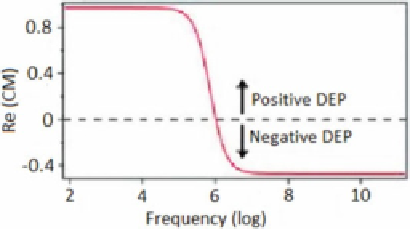Environmental Engineering Reference
In-Depth Information
Fig. 14.6 Variation with
frequency of the real part of
the CM factor for
˃
p
> ˃
m
and
ε
p
< ε
m
particle can experience both positive and negative DEP forces based on the various
possible combinations of the above variables.
Figure
14.6
shows an example of dielectrophoretic spectrum with
˃
p
> ˃
m
and
ε
p
< ε
m
.
The second term of Eq. (
14.7
) is nonvanishing if the electric field has a spatially
dependent phase, and the dielectrophoresis resulting from such an electric field
phase gradient is known as “
traveling wave dielectrophoresis
” (twDEP). In travel-
ing wave dielectrophoresis, the positive DEP force pushes the particles along the
direction of the traveling wave while the negative DEP force pushes them in the
opposite direction.
After inserting the expression for the electric potential phasor in Eq. (
14.7
), the
time-averaged DEP and twDEP forces can be expressed as [
35
,
39
]:
2
2
ˀε
m
a
3
K
R
∇∇
h
F
DEP
i
¼
2
j
V
R
j
þ
∇
j
V
I
j
;
ð
14
:
11
Þ
and, respectively:
ˀε
m
a
3
K
I
∇
∇
h
F
twDEP
i
¼
4
ð
ð
V
R
∇
V
I
Þ
Þ:
ð
14
:
12
Þ
In conclusion, dielectrophoresis can be used as an effective means of separating
particles, solely according to their dielectric properties and size. The real part of the
Clausius-Mossotti factor gives the DEP force in the direction perpendicular to the
electrode array, while the imaginary part gives the twDEP force in the parallel
direction. Nevertheless, a disadvantage to use of DEP is that the DEP forces are
inherently transient and disappear when the field is removed.
14.2.2 Electrorotation
Electrorotation occurs when a dipole sits in a rotating electric field generated
between four electrodes, by applying four 90
phase-shifted AC signals and the
interaction between the electric field and this dipole moment leads to a torque on the
particle [
37
,
38
]. If the field vector changes direction, the vector of the dipole

